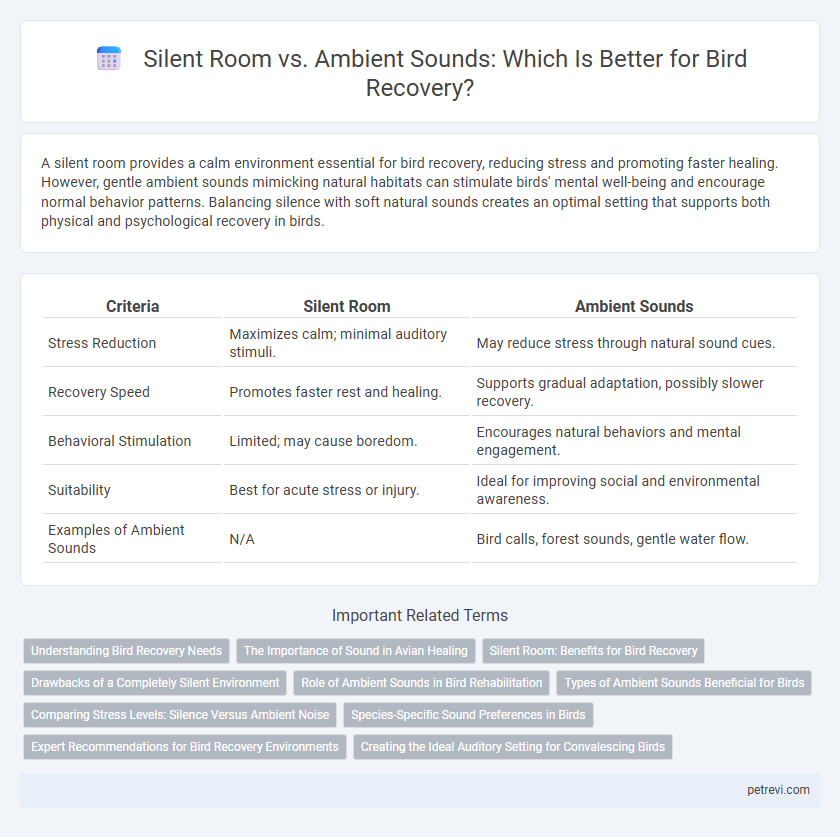A silent room provides a calm environment essential for bird recovery, reducing stress and promoting faster healing. However, gentle ambient sounds mimicking natural habitats can stimulate birds' mental well-being and encourage normal behavior patterns. Balancing silence with soft natural sounds creates an optimal setting that supports both physical and psychological recovery in birds.
Table of Comparison
| Criteria | Silent Room | Ambient Sounds |
|---|---|---|
| Stress Reduction | Maximizes calm; minimal auditory stimuli. | May reduce stress through natural sound cues. |
| Recovery Speed | Promotes faster rest and healing. | Supports gradual adaptation, possibly slower recovery. |
| Behavioral Stimulation | Limited; may cause boredom. | Encourages natural behaviors and mental engagement. |
| Suitability | Best for acute stress or injury. | Ideal for improving social and environmental awareness. |
| Examples of Ambient Sounds | N/A | Bird calls, forest sounds, gentle water flow. |
Understanding Bird Recovery Needs
Bird recovery requires carefully balanced sound environments to minimize stress and support healing. A silent room eliminates disruptive noise, promoting rest and reducing anxiety, while controlled ambient sounds mimic natural habitats, aiding orientation and behavioral recovery. Understanding species-specific needs helps determine whether silence or gentle natural sounds best facilitate optimal rehabilitation outcomes.
The Importance of Sound in Avian Healing
Sound plays a crucial role in avian healing, as ambient sounds resembling natural habitats help reduce stress and promote faster recovery in birds. Silent rooms may lead to increased anxiety and disorientation, hindering the healing process due to the absence of familiar acoustic stimuli. Providing a controlled environment with gentle, natural ambient sounds supports neurological stability and overall well-being during bird rehabilitation.
Silent Room: Benefits for Bird Recovery
A silent room provides an optimal environment for bird recovery by minimizing stress and promoting restful sleep essential for healing. Reduced auditory stimuli prevent agitation and support the bird's natural recovery processes, enhancing immune function and tissue repair. Controlled silence also facilitates faster rehabilitation by allowing birds to conserve energy and focus on recuperation.
Drawbacks of a Completely Silent Environment
A completely silent environment may hinder bird recovery by increasing stress levels due to unnatural sensory deprivation, as birds rely on ambient sounds for navigation and communication. The absence of natural auditory cues can disrupt circadian rhythms and reduce overall well-being. Incorporating gentle ambient sounds that mimic natural habitats supports cognitive function and accelerates rehabilitation.
Role of Ambient Sounds in Bird Rehabilitation
Ambient sounds play a crucial role in bird rehabilitation by providing a naturalistic environment that promotes stress reduction and behavioral normalization. Exposure to carefully curated ambient sounds, such as forest noises or bird calls, aids in cognitive stimulation and facilitates social interactions necessary for recovery. These sounds help birds regain their natural responses, improving their chances of successful reintegration into the wild.
Types of Ambient Sounds Beneficial for Birds
Bird recovery benefits significantly from controlled ambient sounds such as soft natural noises, including gentle rain, rustling leaves, and distant bird calls, which help reduce stress and promote healing. White noise or low-volume classical music can also create a calming environment that mimics natural habitats, aiding in faster recovery. Silence may sometimes increase anxiety in birds accustomed to natural background sounds, making carefully selected ambient sounds a crucial element in rehabilitation settings.
Comparing Stress Levels: Silence Versus Ambient Noise
Birds recover faster in silent rooms where stress hormone levels such as corticosterone significantly decrease compared to environments with ambient noise. Studies show that ambient sounds, especially unpredictable or loud noises, elevate heart rates and cortisol levels, hindering avian recovery processes. Controlled silence creates a calming habitat that boosts immune response and accelerates healing in injured or stressed birds.
Species-Specific Sound Preferences in Birds
Species-specific sound preferences significantly influence bird recovery, as certain birds thrive better in silent rooms while others benefit from ambient sounds mimicking their natural habitats. For example, songbirds like nightingales show improved stress reduction and vocalization in environments with soft, ambient forest sounds, whereas raptors such as hawks are calmer and recover faster in quieter, silent rooms. Tailoring acoustic environments to species needs enhances psychological well-being and accelerates the rehabilitation process in avian recovery centers.
Expert Recommendations for Bird Recovery Environments
Expert recommendations for bird recovery environments emphasize the importance of minimizing stress by providing quiet, low-disturbance settings with ambient sounds that mimic natural habitats. Research indicates that soft natural sounds, such as gentle rustling or distant water flows, promote calming effects and support faster recovery in birds compared to completely silent rooms. Creating an environment with controlled ambient noise helps reduce anxiety and encourages restorative behaviors critical for effective rehabilitation.
Creating the Ideal Auditory Setting for Convalescing Birds
Creating the ideal auditory setting for convalescing birds involves balancing silence with natural ambient sounds that mimic their native environment. Silent rooms minimize stress and promote rest, while gentle bird calls, rustling leaves, and soft water sounds can stimulate recovery by providing familiar auditory cues. Research indicates that exposure to appropriate ambient sounds enhances healing by reducing anxiety and encouraging natural behaviors in recovering avian patients.
Silent room vs Ambient sounds for Bird recovery Infographic

 petrevi.com
petrevi.com